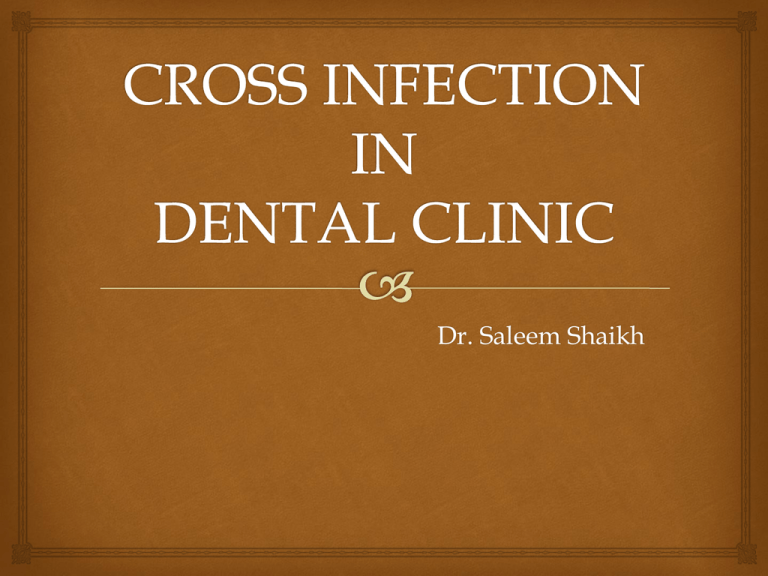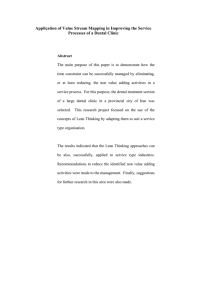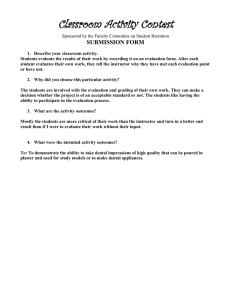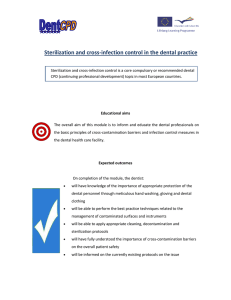oral microbiology lecture - cross infection
advertisement

Dr. Saleem Shaikh Introduction Defn: Cross infection can be defined as the passing of one infection causing microorganism (bacteria, viruses, fungal spores, etc.) from one person to another. This can be directly through contact with an infected person or indirectly through contaminated items. Infection control is a major issue in each dental practice because this is an area where blood or saliva contamination can easily occur. Taking protection measures prior to beginning work Take a detailed medical history Get vaccinated against hepatitis B Make sure all the instruments are sterilized Protect working surfaces Make sure that all the disinfectant fluids and waste containers are present. Hand washing Hand washing is the cornerstone of the ‘patient – doctor – auxiliary staff’ protection circle aiming at the prevention of cross infection. wash hands before and after coming in contact with the patient. After removing the gloves, hands must be carefully washed as very often there are pores in latex allowing the penetration of contaminating matter. Using antimicrobial solutions without prior meticulous hand washing is a defective and inefficient procedure. In case of an injury, scratch or exudative injury, the person should postpone treating patients until the wound is healed. If this is not possible, the use of a double pair of suitable and tolerable gloves is recommended. Gloves The medical and auxiliary staff is obliged to always wear gloves during any dental work which involves contact with blood or saliva containing blood or mucus. Gloves are used during any dental work, for a single patient only and, afterwards, they are removed and discarded. Washing the gloves and performing any dental work to another patient is strictly forbidden. In patients with confirmed HIV or HBV and HCV infection, it is recommended that double gloves are used for the protection of the surgeon. If during any dental work it is necessary to use an extra device or material, gloves should be covered with an extra pair of nylon gloves so that contamination of those surfaces is prevented. Mask and glasses During the examination or any dental work, an appropriate mask and eye protectors are necessary. Masks must be able to withhold at least 95% of the microorganisms. In case the dental patient suffers from an airborne disease (tuberculosis), the mask must be enhanced and fully adaptable to the wearer’s face. Also, it must be able to withhold particles and microorganisms with a diameter up to 1μm, at a percentage of 95% (aspirator N95, FFP3). If the mask gets wet it must be immediately discarded and replaced. Eye protectors may include various types of glasses or plastic masks or shields made of transparent materials. The side frame should be wide enough to cover adequately the eye. These protectors must be rinsed with abundant water and get disinfected in case they get stained in between the patients. Dental clothing & Surface coverings They must be changed on a daily basis and definitely as soon as they get stained. If the operation is expected to involve a large amount of bleeding or the patient is likely to be seropositive, it is highly recommended that specially designed single-use clothing [disposable] be used. Any surfaces, devices, electric switches, door handles, drawer knobs, taps, handles and device tubes not able to be sterilised or disinfected, should be meticulously covered with appropriate materials, such as: special rollers and plasticized paper sheets, cellulose film, aluminium foil, self-adhesive films, These protective coverings should be replaced after every contact and every patient Cleaning and Sterilization of dental instruments Any dental hand instrument used during a dental incident must undergo a cleaning and sterilization procedure. Right after the completion of the incident (examination, restoration, surgery) the instruments must be discarded in a special plastic container filled with an appropriate disinfectant solution or enzyme solution with a proteolytic action. they are then transferred to the machine washer where they undergo thorough mechanical cleaning using the appropriate detergents. Manual cleaning is not recommended due to the high risk involved in causing injuries and because it is inferior to mechanical cleaning in terms of quality. After the instruments have been cleaned, they are packaged in special bags or perforated cassettes and they are taken to the autoclaves to be sterilized. Use and care of sharp instruments and needles Sharp instruments, having been in contact with blood and saliva, should be used with special care so that injuries are prevented. Place any surgical blade and needle within a solid, hard plastic container for sharp instruments. Used needles must not be recapped with both hands The 'one hand' technique to recap the needle or a mechanical means designed to hold the cap should always be used. Sterilization of handpieces and burrs Sterilizing the handpieces requires special attention the external surfaces of the handpiece have come in contact with saliva, blood, dental tissue debris and residues of dental materials. However, it is likely that the internal tubes of the handpieces are infected due to various hydrodynamic phenomena taking place on their tip 1) burrs made of common carbon steel should not be placed in the autoclave because they are oxidized. 2) on the contrary, burrs made of stainless steel or tungsten carbide are not affected. 3) dry heat ovens, ovens for chemical vapour sterilisation and ethylene oxide ovens are suitable for sterilising all types of burrs. However, dry heat ovens, due to prolonged heating involved, may seriously damage the cutting edge of the burrs. Taking protection measures after ending work Before you clean the working surfaces, wear thick work gloves, so that your hands are covered and are not exposed to blood and other biological fluids left on surfaces or instruments. Remove any protective cover Clean and sterilize all the instruments and disinfect the working surfaces Place and remove any used waste Remove your gloves and wash your hands





